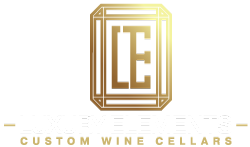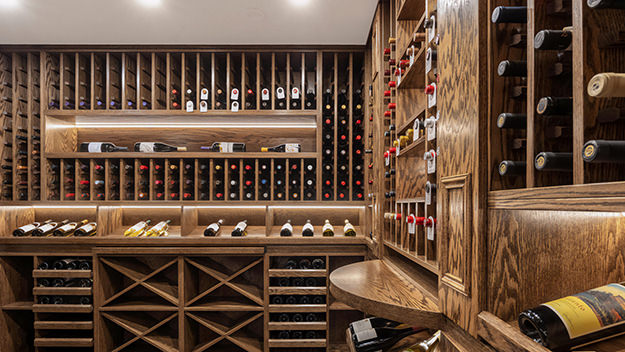
CUSTOM-CRAFTED TRADITIONAL WINE CELLARS
Traditionally designed wine cellars pay homage to the classic early European cellars. The use of wood, brick or stone are the most common materials used in this style which are often located in the entertainment areas of a basement setting. Wood racks are recommended in a traditional-style wine cellar with a darker stain which will show off the beautiful graining of any wood selected.
The prudent use of artificial lighting can illuminate the design aspects of the cellar and any traditional décor that may be incorporated. Luxury Elements’ team of Chicagoland experts can design a traditional wine cellar that will be a welcome addition to any home and will display a wine collection in an elegant Old World setting.
Interested in a customized quote? Contact us today.
7-STEP PROCESS TO A BEAUTIFUL WINE CELLAR
At Luxury Elements, we give every client our full attention in order to guarantee their ideas for their custom wine storage area are completely fulfilled to their satisfaction. We follow the same 7-step procedure for every project to ensure the final result will be exactly what the customer expected and that the customer’s overall experience is a positive one.
STEP ONE
Schedule an appointment: Contact Luxury Elements to schedule a no-obligation appointment.
STEP TWO
Site visit: One of our design consultants will visit the client’s home or office to discuss their ideas and go over design options, show material samples and walk-through videos of other wine cellar projects. Then the designated location will be carefully measured.
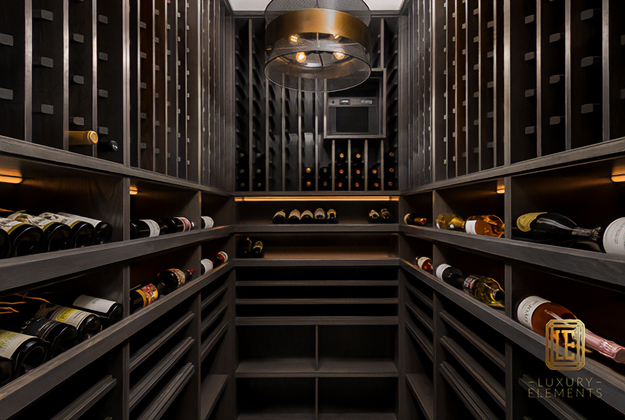
STEP THREE
Wine Cellar Design: Following the site visit, our designers, using state-of-the-art CAD programs, will design the wine cellar based on our discussions and space availability.
STEP FOUR
Design Changes: Luxury Elements will soon present a carefully detailed design. At this time, any changes, alterations or modifications will be discussed and then incorporated into a final design.
STEP FIVE
Final Design Presentation and Agreement: A final design will be presented to the customer and if agreed upon, an estimate will be presented and a contractual agreement will be signed and the build process will begin.
STEP SIX
Final Preparation - Ordering Components: Specialized components to fit the client’s custom cellar design such as the cooling unit, doors, luminaire, wall, ceiling and flooring materials, etc. will be ordered and readied for installation.
STEP SEVEN
Build and Installation Process: Our experienced professional installers will arrive to begin the installation process. Depending on the particular location, the work may include concrete floor sealing and vapor barrier installation, framing and insulation, cooling unit installation and finishing of the walls and ceiling as well as flooring and door installation. And finally, the racks themselves are installed as well as lighting fixtures, and other features. Soon, the beautiful Luxury Elements custom-built wine cellar will be complete and ready for the client to enjoy.
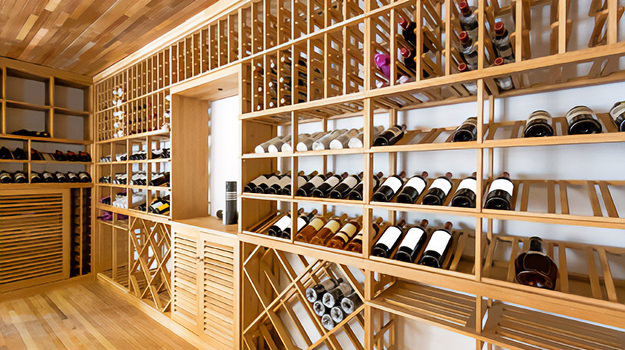
SELECTING WOOD FOR A WINE CELLAR
The decision to have a wine cellar designed and built is a significant one. There are several important components in the process not the least of which is the selection of wood to be used in this endeavor. Luxury Elements suggests the client give this facet a great deal of thought and consideration.
There are literally hundreds of different wood species available from Abachi to Zigang, however we recommend the following for your project: Cherry, Hickory, Mahogany, Maple, Red Oak, Redwood, Walnut, or White Oak.
Cherry is a dense hardwood with nice graining and is an excellent choice for wine cellars. It is stiff and strong and holds up well in a controlled cellar environment.
Hickory is one of the hardest woods available and is used where strength and shock resistance is required. It comes with various grain patterns and is a furniture and cabinet maker’s favorite.
Mahogany is a very durable, stable wood and comes in a variety of colors. There are several types of mahogany, in various price ranges from the expensive Genuine Mahogany to less expensive Malaysian Mahogany.
Maple comes in a number of varieties each with unique graining. This hardwood, often used in furniture building, is very durable and stable.
Red Oak is a classic choice that is heavy with a course texture and stains beautifully. Red oak is often used for flooring and is extremely durable.
Redwood. Although a soft wood, it is widely considered one of the best for wine cellars. It is durable with natural oils that help repel moisture and will maintain its form unlike other soft woods such as pine and those from other conifers.
Walnut is an extremely hard wood and is highly resistant to shrinkage or warping and a cabinet maker’s favorite. For these reasons, it is an outstanding choice for an environmentally controlled wine cellar.
White Oak is another hardwood that is often used for wine cellars. As with red oak, it is a heavy wood with beautiful graining and stains up nicely.
All woods are not created equal so the client needs to take into consideration but is not limited to durability, affordability, and of course, aesthetic appeal. Whatever wood is selected, take heart knowing that a Luxury Elements’ built wine cellar will look beautiful for generations to come.
OUR THREE PART WINE CELLAR DESIGN PROCESS
The design process in any construction project is the collaboration between the client and the designer. Throughout the planning stage, it is crucial to maintain an open line of communication so the client’s vision for their wine cellar/wine room can become a reality exactly as imagined.
During the entire design process, we offer many opportunities for the client to make changes, additions or corrections to the design and we welcome and encourage client feedback. To ensure Luxury Elements and the client have a complete understanding of the project, we have broken down the design process into three distinct chronological segments.
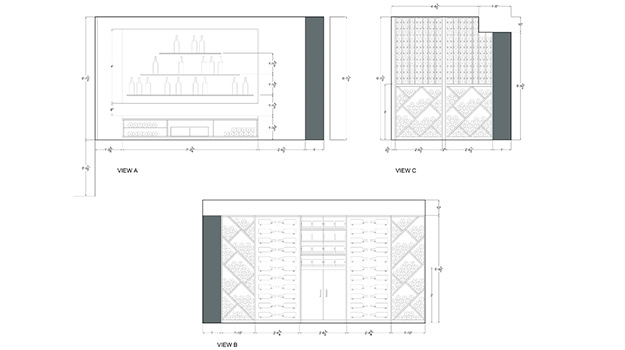
STEP ONE - Two Dimensional (2D) Modeling
The first architectural document the client will receive will be a 2D or two dimensional model or line drawing. 2D drawings are created using Luxury Elements’ state-of-the-art computer (CAD) program and is the first draft, a starting point, using the information and measurements gleaned from the initial site visit and discussions with the client. A two dimensional (2D) model involves the creation of a blueprint or drawing showing an overhead view of a project. This document will describe the basic layout of the site and where objects are placed, but will not include the dimension of depth.
This drawing is the initial depiction of the project that the client will see and will show a preliminary view of the floor plan giving the client an understanding of the space and how it will be used. It will also show the placement and position of the wine racks, doors and other interior objects. This is also the first opportunity for the client to make any changes or corrections to the design.
STEP TWO - Three Dimensional (3D) Modeling
Three Dimensional (3D) modeling is an expansion of the 2D drawing and adds a third dimension (depth) where there is more visual information that is included in the resulting model. A 3D geometric model allows both the client and the builder the ability to clearly understand the complexities of the project and visualize it in more realistic terms. This is crucial during the design phase and is yet again another opportunity when design alterations can be made.

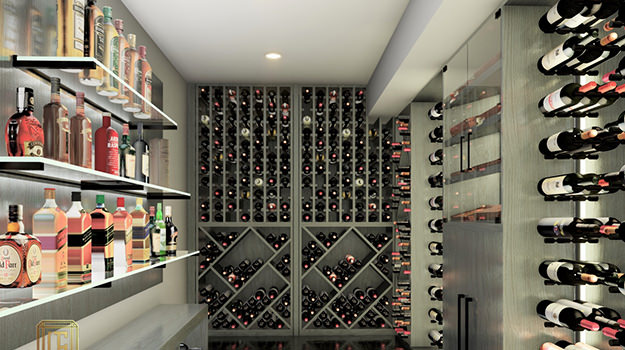
STEP THREE- Three Dimensional (3D) Rendering
A three-dimensional (3D) rendering is a computer-designed realistic snapshot of the wine cellar or wine room that has not yet been physically built. Viewed as the final step in the computer-aided design process, a 3D rendering gives clients an opportunity to again review the design and see how it would look in the real world. To accomplish this, texturing, wood tones, flooring, lighting and shadows have been added to the 3D model for a better, almost photographic visualization.
The three-step design process has gone from the client's idea for a wine cellar or room to a 2D model or line drawing to a 3D model and finally to a full-color 3D rendering. And of course, during the entire process, the client has been encouraged to work closely with Luxury Elements’ design team to ensure the design satisfies the client's expectations. At this point, with the client’s approval of the final design, Luxury Elements will then proceed with the estimation process.
